Classroom Practices: Teaching Techniques and Learning Process
VerifiedAdded on 2022/01/04
|6
|1540
|446
Essay
AI Summary
This essay delves into the multifaceted realm of classroom practices, examining their influence on the teaching and learning process. It explores various techniques, designs, and skills employed by teachers to facilitate optimal learning environments. The study synthesizes insights from selected readings to provide a comprehensive overview of classroom practices, emphasizing the importance of learner-centric approaches, curriculum design, and cultural sensitivity. It also highlights the significance of self-reflection and inclusive teaching. The essay discusses the impact of minimal versus strong instruction, the role of curriculum in either hindering or facilitating learning, and the importance of cross-cultural communication. It emphasizes that effective classroom practices should prioritize learning by providing opportunities for self-recognition of meta-cognition levels and creating an inclusive environment. Overall, the essay underscores the need for teachers to act as facilitators, allowing students to learn through experience and adapt teaching methods to suit diverse learning styles.
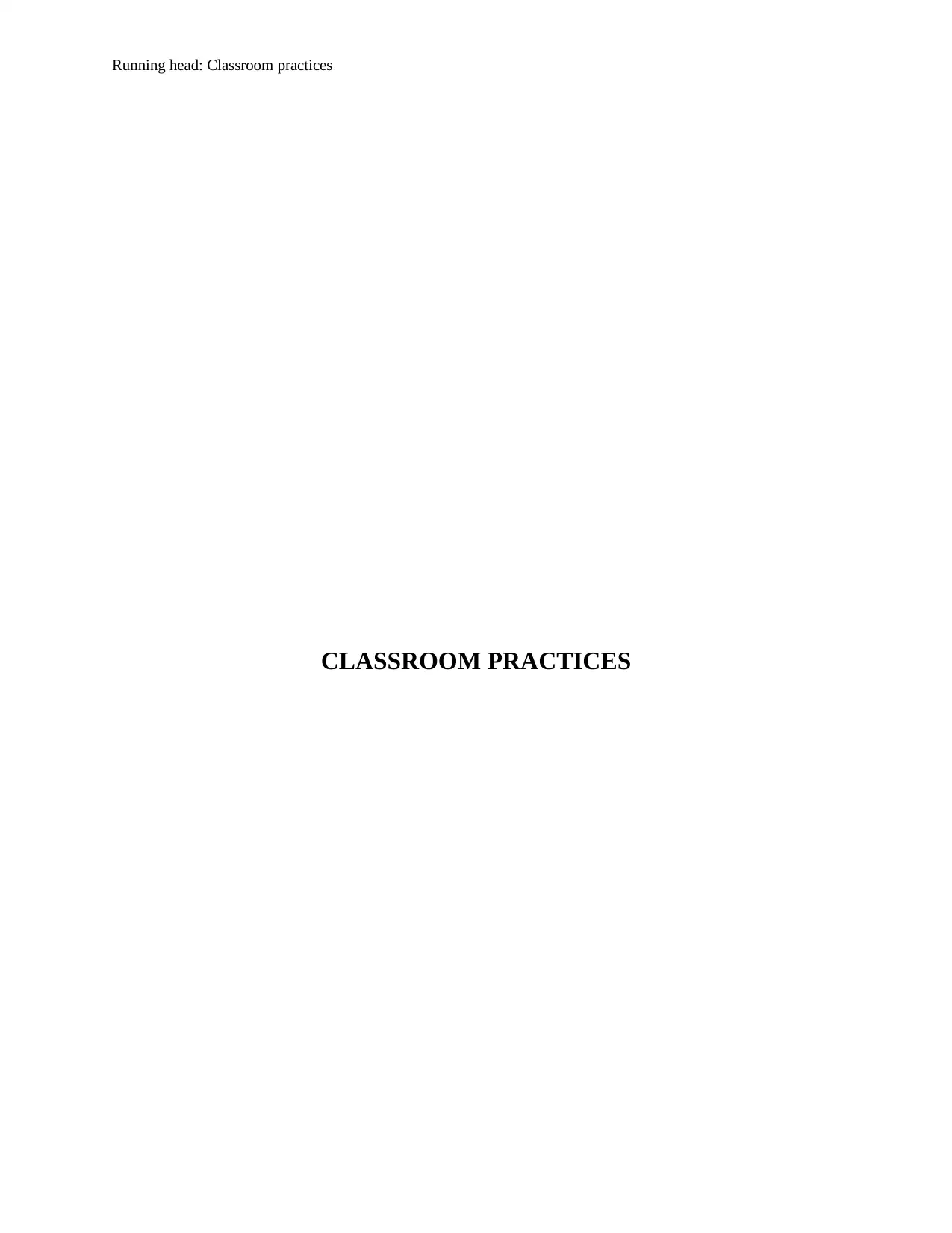
Running head: Classroom practices
CLASSROOM PRACTICES
CLASSROOM PRACTICES
Paraphrase This Document
Need a fresh take? Get an instant paraphrase of this document with our AI Paraphraser
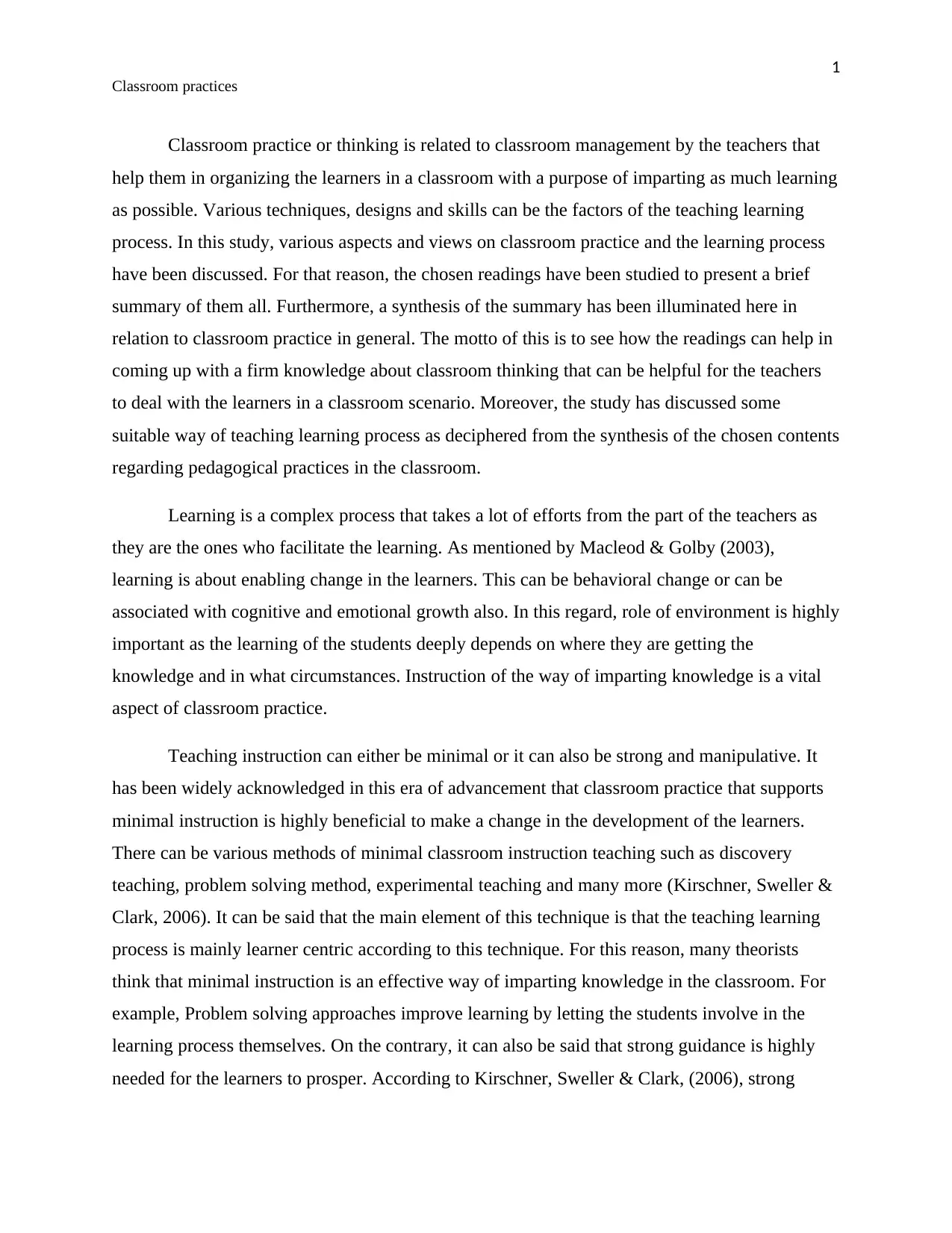
1
Classroom practices
Classroom practice or thinking is related to classroom management by the teachers that
help them in organizing the learners in a classroom with a purpose of imparting as much learning
as possible. Various techniques, designs and skills can be the factors of the teaching learning
process. In this study, various aspects and views on classroom practice and the learning process
have been discussed. For that reason, the chosen readings have been studied to present a brief
summary of them all. Furthermore, a synthesis of the summary has been illuminated here in
relation to classroom practice in general. The motto of this is to see how the readings can help in
coming up with a firm knowledge about classroom thinking that can be helpful for the teachers
to deal with the learners in a classroom scenario. Moreover, the study has discussed some
suitable way of teaching learning process as deciphered from the synthesis of the chosen contents
regarding pedagogical practices in the classroom.
Learning is a complex process that takes a lot of efforts from the part of the teachers as
they are the ones who facilitate the learning. As mentioned by Macleod & Golby (2003),
learning is about enabling change in the learners. This can be behavioral change or can be
associated with cognitive and emotional growth also. In this regard, role of environment is highly
important as the learning of the students deeply depends on where they are getting the
knowledge and in what circumstances. Instruction of the way of imparting knowledge is a vital
aspect of classroom practice.
Teaching instruction can either be minimal or it can also be strong and manipulative. It
has been widely acknowledged in this era of advancement that classroom practice that supports
minimal instruction is highly beneficial to make a change in the development of the learners.
There can be various methods of minimal classroom instruction teaching such as discovery
teaching, problem solving method, experimental teaching and many more (Kirschner, Sweller &
Clark, 2006). It can be said that the main element of this technique is that the teaching learning
process is mainly learner centric according to this technique. For this reason, many theorists
think that minimal instruction is an effective way of imparting knowledge in the classroom. For
example, Problem solving approaches improve learning by letting the students involve in the
learning process themselves. On the contrary, it can also be said that strong guidance is highly
needed for the learners to prosper. According to Kirschner, Sweller & Clark, (2006), strong
Classroom practices
Classroom practice or thinking is related to classroom management by the teachers that
help them in organizing the learners in a classroom with a purpose of imparting as much learning
as possible. Various techniques, designs and skills can be the factors of the teaching learning
process. In this study, various aspects and views on classroom practice and the learning process
have been discussed. For that reason, the chosen readings have been studied to present a brief
summary of them all. Furthermore, a synthesis of the summary has been illuminated here in
relation to classroom practice in general. The motto of this is to see how the readings can help in
coming up with a firm knowledge about classroom thinking that can be helpful for the teachers
to deal with the learners in a classroom scenario. Moreover, the study has discussed some
suitable way of teaching learning process as deciphered from the synthesis of the chosen contents
regarding pedagogical practices in the classroom.
Learning is a complex process that takes a lot of efforts from the part of the teachers as
they are the ones who facilitate the learning. As mentioned by Macleod & Golby (2003),
learning is about enabling change in the learners. This can be behavioral change or can be
associated with cognitive and emotional growth also. In this regard, role of environment is highly
important as the learning of the students deeply depends on where they are getting the
knowledge and in what circumstances. Instruction of the way of imparting knowledge is a vital
aspect of classroom practice.
Teaching instruction can either be minimal or it can also be strong and manipulative. It
has been widely acknowledged in this era of advancement that classroom practice that supports
minimal instruction is highly beneficial to make a change in the development of the learners.
There can be various methods of minimal classroom instruction teaching such as discovery
teaching, problem solving method, experimental teaching and many more (Kirschner, Sweller &
Clark, 2006). It can be said that the main element of this technique is that the teaching learning
process is mainly learner centric according to this technique. For this reason, many theorists
think that minimal instruction is an effective way of imparting knowledge in the classroom. For
example, Problem solving approaches improve learning by letting the students involve in the
learning process themselves. On the contrary, it can also be said that strong guidance is highly
needed for the learners to prosper. According to Kirschner, Sweller & Clark, (2006), strong
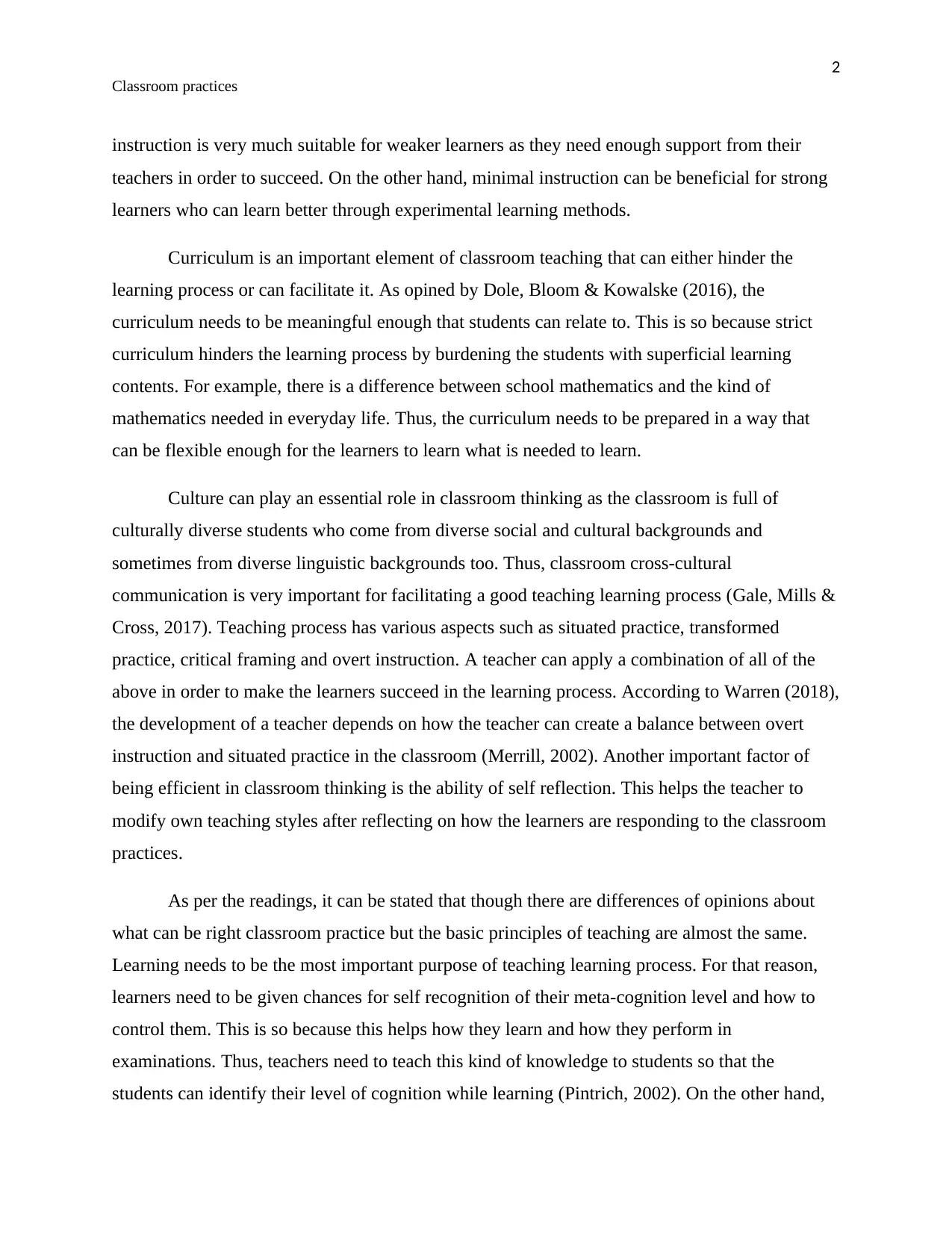
2
Classroom practices
instruction is very much suitable for weaker learners as they need enough support from their
teachers in order to succeed. On the other hand, minimal instruction can be beneficial for strong
learners who can learn better through experimental learning methods.
Curriculum is an important element of classroom teaching that can either hinder the
learning process or can facilitate it. As opined by Dole, Bloom & Kowalske (2016), the
curriculum needs to be meaningful enough that students can relate to. This is so because strict
curriculum hinders the learning process by burdening the students with superficial learning
contents. For example, there is a difference between school mathematics and the kind of
mathematics needed in everyday life. Thus, the curriculum needs to be prepared in a way that
can be flexible enough for the learners to learn what is needed to learn.
Culture can play an essential role in classroom thinking as the classroom is full of
culturally diverse students who come from diverse social and cultural backgrounds and
sometimes from diverse linguistic backgrounds too. Thus, classroom cross-cultural
communication is very important for facilitating a good teaching learning process (Gale, Mills &
Cross, 2017). Teaching process has various aspects such as situated practice, transformed
practice, critical framing and overt instruction. A teacher can apply a combination of all of the
above in order to make the learners succeed in the learning process. According to Warren (2018),
the development of a teacher depends on how the teacher can create a balance between overt
instruction and situated practice in the classroom (Merrill, 2002). Another important factor of
being efficient in classroom thinking is the ability of self reflection. This helps the teacher to
modify own teaching styles after reflecting on how the learners are responding to the classroom
practices.
As per the readings, it can be stated that though there are differences of opinions about
what can be right classroom practice but the basic principles of teaching are almost the same.
Learning needs to be the most important purpose of teaching learning process. For that reason,
learners need to be given chances for self recognition of their meta-cognition level and how to
control them. This is so because this helps how they learn and how they perform in
examinations. Thus, teachers need to teach this kind of knowledge to students so that the
students can identify their level of cognition while learning (Pintrich, 2002). On the other hand,
Classroom practices
instruction is very much suitable for weaker learners as they need enough support from their
teachers in order to succeed. On the other hand, minimal instruction can be beneficial for strong
learners who can learn better through experimental learning methods.
Curriculum is an important element of classroom teaching that can either hinder the
learning process or can facilitate it. As opined by Dole, Bloom & Kowalske (2016), the
curriculum needs to be meaningful enough that students can relate to. This is so because strict
curriculum hinders the learning process by burdening the students with superficial learning
contents. For example, there is a difference between school mathematics and the kind of
mathematics needed in everyday life. Thus, the curriculum needs to be prepared in a way that
can be flexible enough for the learners to learn what is needed to learn.
Culture can play an essential role in classroom thinking as the classroom is full of
culturally diverse students who come from diverse social and cultural backgrounds and
sometimes from diverse linguistic backgrounds too. Thus, classroom cross-cultural
communication is very important for facilitating a good teaching learning process (Gale, Mills &
Cross, 2017). Teaching process has various aspects such as situated practice, transformed
practice, critical framing and overt instruction. A teacher can apply a combination of all of the
above in order to make the learners succeed in the learning process. According to Warren (2018),
the development of a teacher depends on how the teacher can create a balance between overt
instruction and situated practice in the classroom (Merrill, 2002). Another important factor of
being efficient in classroom thinking is the ability of self reflection. This helps the teacher to
modify own teaching styles after reflecting on how the learners are responding to the classroom
practices.
As per the readings, it can be stated that though there are differences of opinions about
what can be right classroom practice but the basic principles of teaching are almost the same.
Learning needs to be the most important purpose of teaching learning process. For that reason,
learners need to be given chances for self recognition of their meta-cognition level and how to
control them. This is so because this helps how they learn and how they perform in
examinations. Thus, teachers need to teach this kind of knowledge to students so that the
students can identify their level of cognition while learning (Pintrich, 2002). On the other hand,
⊘ This is a preview!⊘
Do you want full access?
Subscribe today to unlock all pages.

Trusted by 1+ million students worldwide
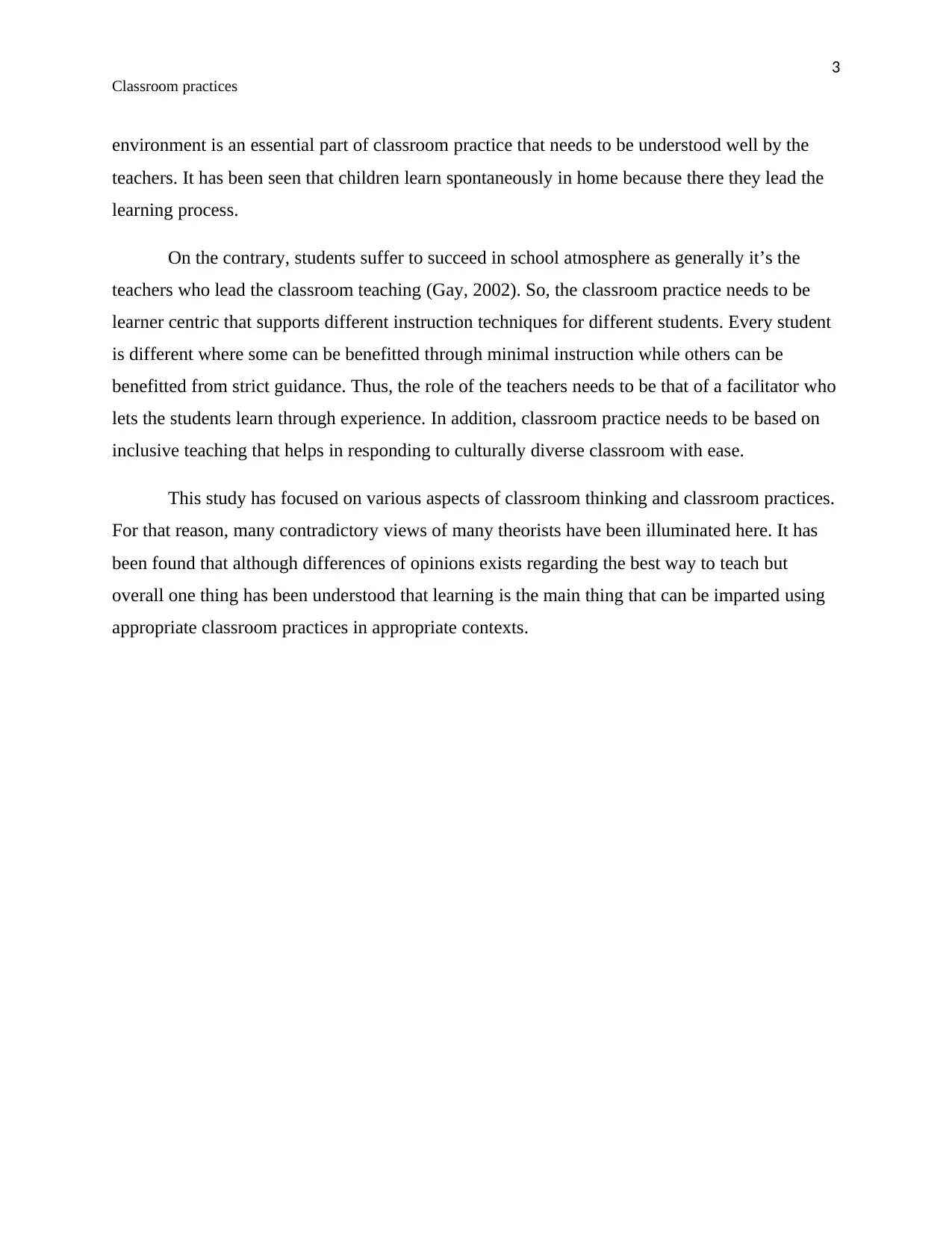
3
Classroom practices
environment is an essential part of classroom practice that needs to be understood well by the
teachers. It has been seen that children learn spontaneously in home because there they lead the
learning process.
On the contrary, students suffer to succeed in school atmosphere as generally it’s the
teachers who lead the classroom teaching (Gay, 2002). So, the classroom practice needs to be
learner centric that supports different instruction techniques for different students. Every student
is different where some can be benefitted through minimal instruction while others can be
benefitted from strict guidance. Thus, the role of the teachers needs to be that of a facilitator who
lets the students learn through experience. In addition, classroom practice needs to be based on
inclusive teaching that helps in responding to culturally diverse classroom with ease.
This study has focused on various aspects of classroom thinking and classroom practices.
For that reason, many contradictory views of many theorists have been illuminated here. It has
been found that although differences of opinions exists regarding the best way to teach but
overall one thing has been understood that learning is the main thing that can be imparted using
appropriate classroom practices in appropriate contexts.
Classroom practices
environment is an essential part of classroom practice that needs to be understood well by the
teachers. It has been seen that children learn spontaneously in home because there they lead the
learning process.
On the contrary, students suffer to succeed in school atmosphere as generally it’s the
teachers who lead the classroom teaching (Gay, 2002). So, the classroom practice needs to be
learner centric that supports different instruction techniques for different students. Every student
is different where some can be benefitted through minimal instruction while others can be
benefitted from strict guidance. Thus, the role of the teachers needs to be that of a facilitator who
lets the students learn through experience. In addition, classroom practice needs to be based on
inclusive teaching that helps in responding to culturally diverse classroom with ease.
This study has focused on various aspects of classroom thinking and classroom practices.
For that reason, many contradictory views of many theorists have been illuminated here. It has
been found that although differences of opinions exists regarding the best way to teach but
overall one thing has been understood that learning is the main thing that can be imparted using
appropriate classroom practices in appropriate contexts.
Paraphrase This Document
Need a fresh take? Get an instant paraphrase of this document with our AI Paraphraser
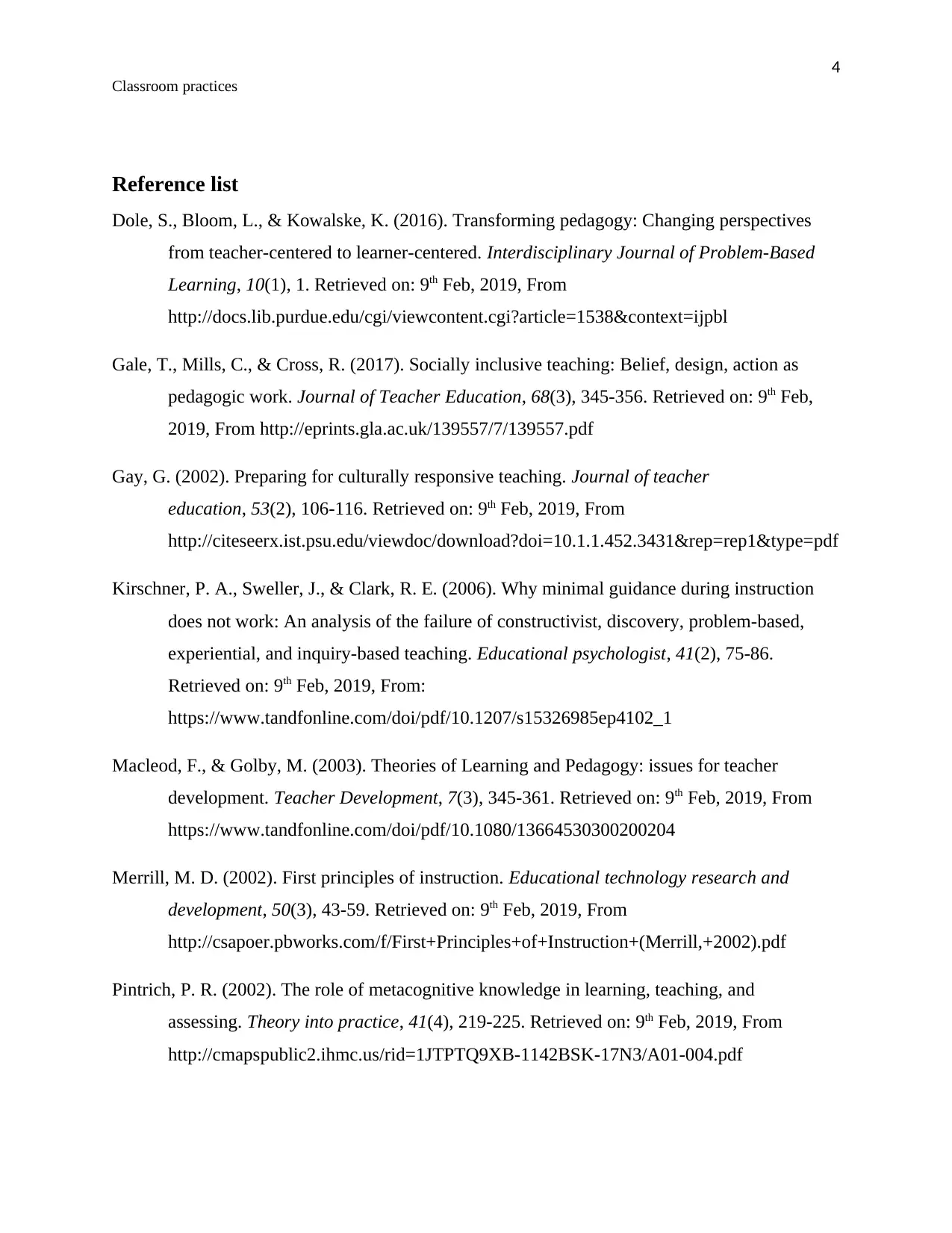
4
Classroom practices
Reference list
Dole, S., Bloom, L., & Kowalske, K. (2016). Transforming pedagogy: Changing perspectives
from teacher-centered to learner-centered. Interdisciplinary Journal of Problem-Based
Learning, 10(1), 1. Retrieved on: 9th Feb, 2019, From
http://docs.lib.purdue.edu/cgi/viewcontent.cgi?article=1538&context=ijpbl
Gale, T., Mills, C., & Cross, R. (2017). Socially inclusive teaching: Belief, design, action as
pedagogic work. Journal of Teacher Education, 68(3), 345-356. Retrieved on: 9th Feb,
2019, From http://eprints.gla.ac.uk/139557/7/139557.pdf
Gay, G. (2002). Preparing for culturally responsive teaching. Journal of teacher
education, 53(2), 106-116. Retrieved on: 9th Feb, 2019, From
http://citeseerx.ist.psu.edu/viewdoc/download?doi=10.1.1.452.3431&rep=rep1&type=pdf
Kirschner, P. A., Sweller, J., & Clark, R. E. (2006). Why minimal guidance during instruction
does not work: An analysis of the failure of constructivist, discovery, problem-based,
experiential, and inquiry-based teaching. Educational psychologist, 41(2), 75-86.
Retrieved on: 9th Feb, 2019, From:
https://www.tandfonline.com/doi/pdf/10.1207/s15326985ep4102_1
Macleod, F., & Golby, M. (2003). Theories of Learning and Pedagogy: issues for teacher
development. Teacher Development, 7(3), 345-361. Retrieved on: 9th Feb, 2019, From
https://www.tandfonline.com/doi/pdf/10.1080/13664530300200204
Merrill, M. D. (2002). First principles of instruction. Educational technology research and
development, 50(3), 43-59. Retrieved on: 9th Feb, 2019, From
http://csapoer.pbworks.com/f/First+Principles+of+Instruction+(Merrill,+2002).pdf
Pintrich, P. R. (2002). The role of metacognitive knowledge in learning, teaching, and
assessing. Theory into practice, 41(4), 219-225. Retrieved on: 9th Feb, 2019, From
http://cmapspublic2.ihmc.us/rid=1JTPTQ9XB-1142BSK-17N3/A01-004.pdf
Classroom practices
Reference list
Dole, S., Bloom, L., & Kowalske, K. (2016). Transforming pedagogy: Changing perspectives
from teacher-centered to learner-centered. Interdisciplinary Journal of Problem-Based
Learning, 10(1), 1. Retrieved on: 9th Feb, 2019, From
http://docs.lib.purdue.edu/cgi/viewcontent.cgi?article=1538&context=ijpbl
Gale, T., Mills, C., & Cross, R. (2017). Socially inclusive teaching: Belief, design, action as
pedagogic work. Journal of Teacher Education, 68(3), 345-356. Retrieved on: 9th Feb,
2019, From http://eprints.gla.ac.uk/139557/7/139557.pdf
Gay, G. (2002). Preparing for culturally responsive teaching. Journal of teacher
education, 53(2), 106-116. Retrieved on: 9th Feb, 2019, From
http://citeseerx.ist.psu.edu/viewdoc/download?doi=10.1.1.452.3431&rep=rep1&type=pdf
Kirschner, P. A., Sweller, J., & Clark, R. E. (2006). Why minimal guidance during instruction
does not work: An analysis of the failure of constructivist, discovery, problem-based,
experiential, and inquiry-based teaching. Educational psychologist, 41(2), 75-86.
Retrieved on: 9th Feb, 2019, From:
https://www.tandfonline.com/doi/pdf/10.1207/s15326985ep4102_1
Macleod, F., & Golby, M. (2003). Theories of Learning and Pedagogy: issues for teacher
development. Teacher Development, 7(3), 345-361. Retrieved on: 9th Feb, 2019, From
https://www.tandfonline.com/doi/pdf/10.1080/13664530300200204
Merrill, M. D. (2002). First principles of instruction. Educational technology research and
development, 50(3), 43-59. Retrieved on: 9th Feb, 2019, From
http://csapoer.pbworks.com/f/First+Principles+of+Instruction+(Merrill,+2002).pdf
Pintrich, P. R. (2002). The role of metacognitive knowledge in learning, teaching, and
assessing. Theory into practice, 41(4), 219-225. Retrieved on: 9th Feb, 2019, From
http://cmapspublic2.ihmc.us/rid=1JTPTQ9XB-1142BSK-17N3/A01-004.pdf
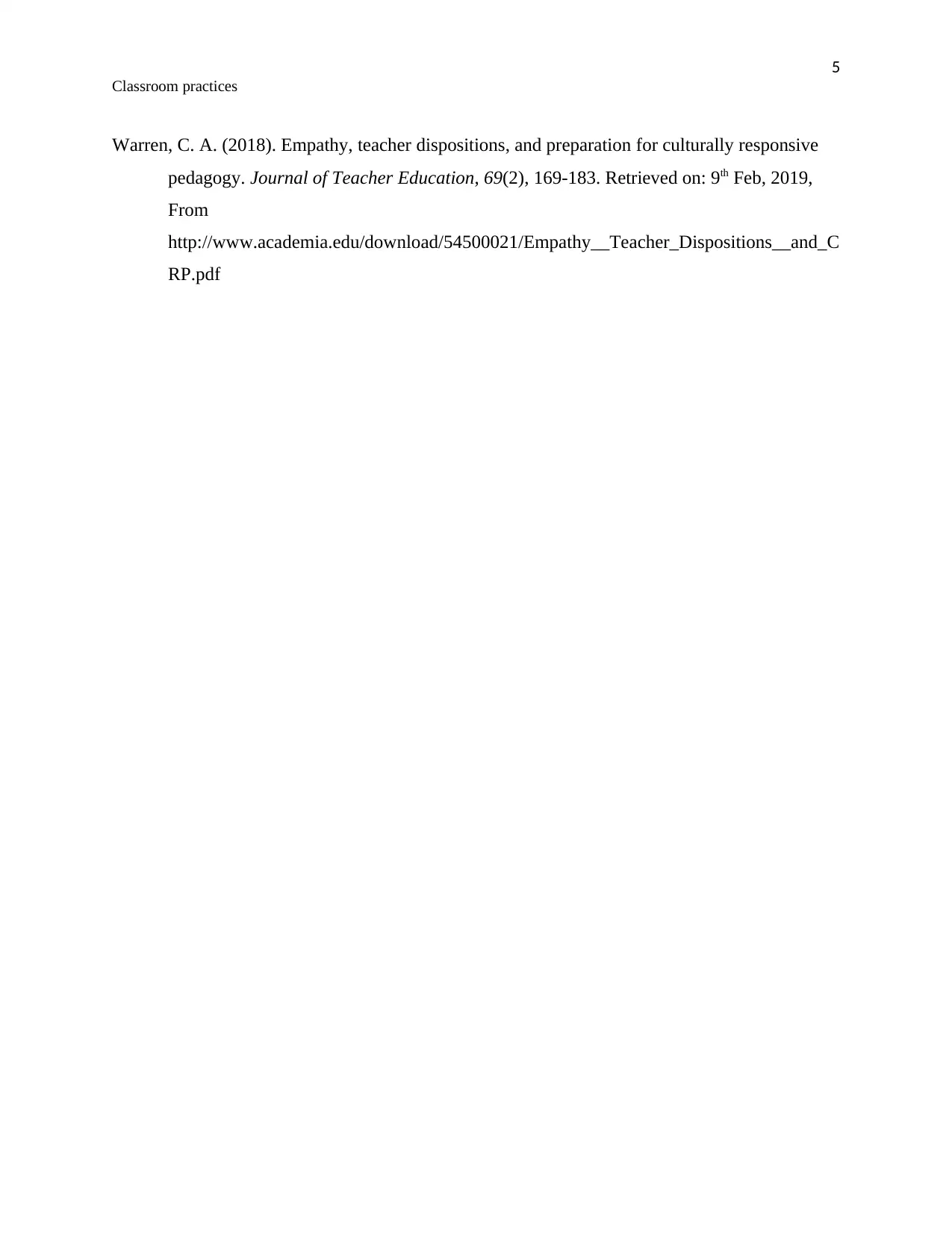
5
Classroom practices
Warren, C. A. (2018). Empathy, teacher dispositions, and preparation for culturally responsive
pedagogy. Journal of Teacher Education, 69(2), 169-183. Retrieved on: 9th Feb, 2019,
From
http://www.academia.edu/download/54500021/Empathy__Teacher_Dispositions__and_C
RP.pdf
Classroom practices
Warren, C. A. (2018). Empathy, teacher dispositions, and preparation for culturally responsive
pedagogy. Journal of Teacher Education, 69(2), 169-183. Retrieved on: 9th Feb, 2019,
From
http://www.academia.edu/download/54500021/Empathy__Teacher_Dispositions__and_C
RP.pdf
⊘ This is a preview!⊘
Do you want full access?
Subscribe today to unlock all pages.

Trusted by 1+ million students worldwide
1 out of 6
Related Documents
Your All-in-One AI-Powered Toolkit for Academic Success.
+13062052269
info@desklib.com
Available 24*7 on WhatsApp / Email
![[object Object]](/_next/static/media/star-bottom.7253800d.svg)
Unlock your academic potential
Copyright © 2020–2025 A2Z Services. All Rights Reserved. Developed and managed by ZUCOL.





